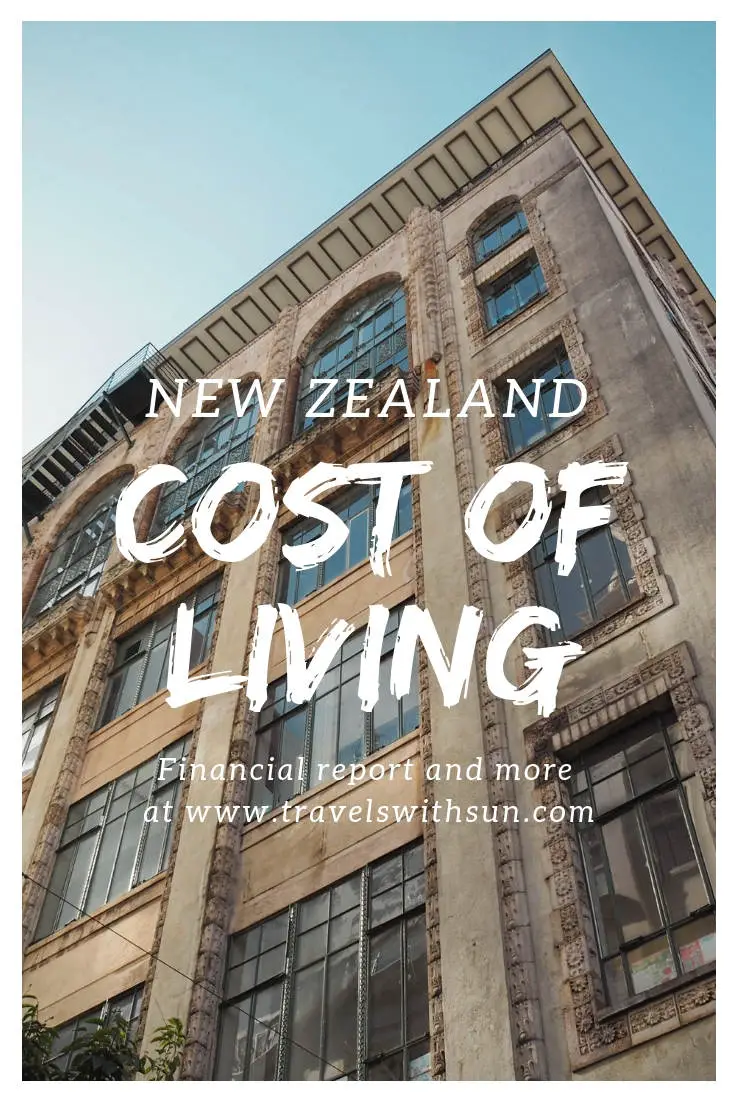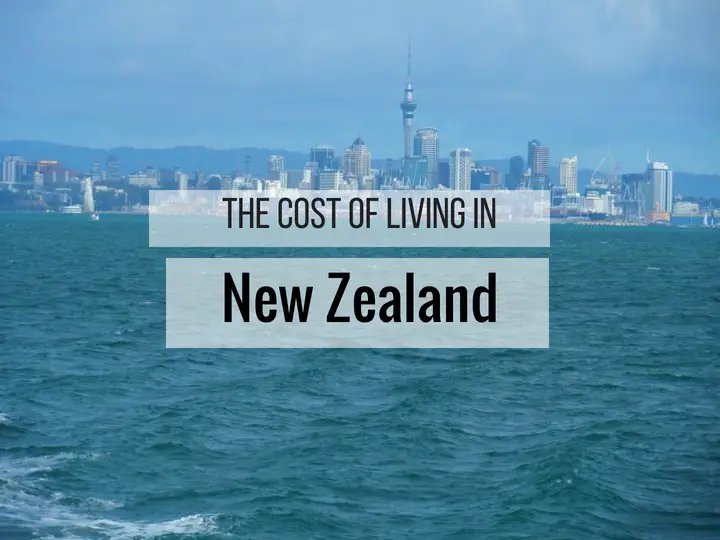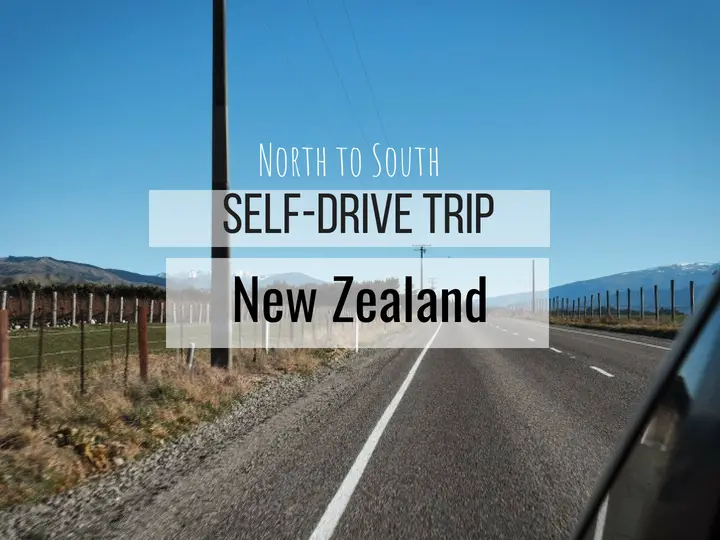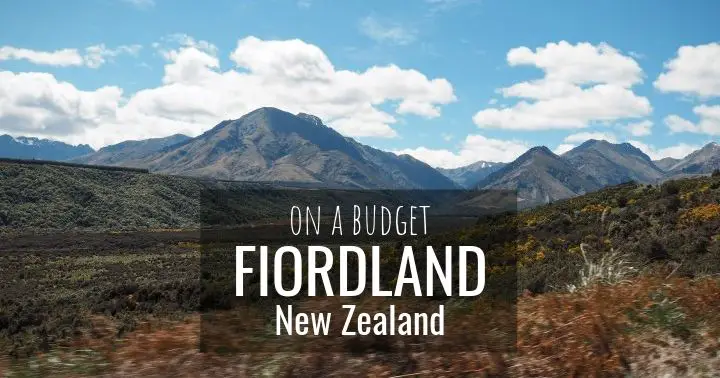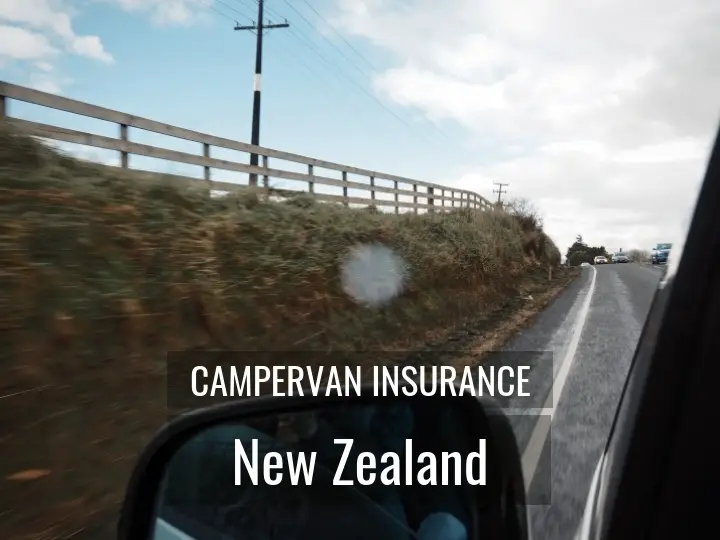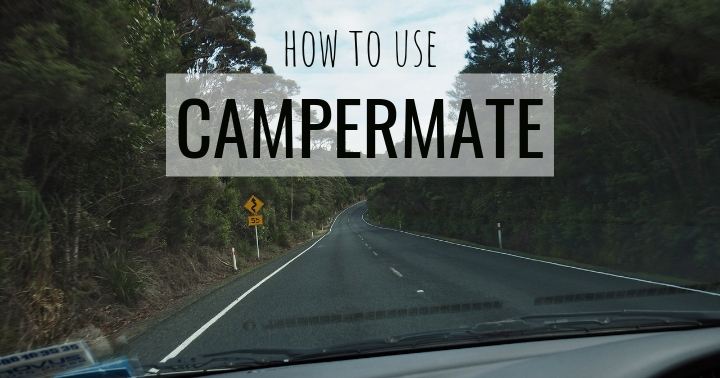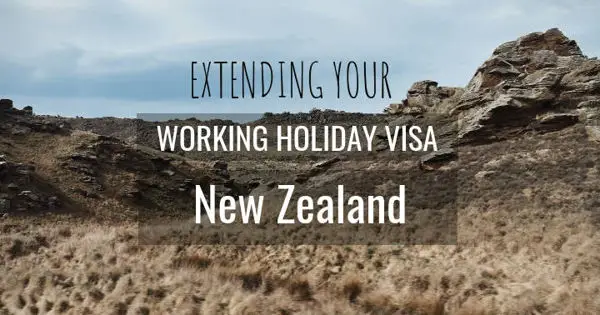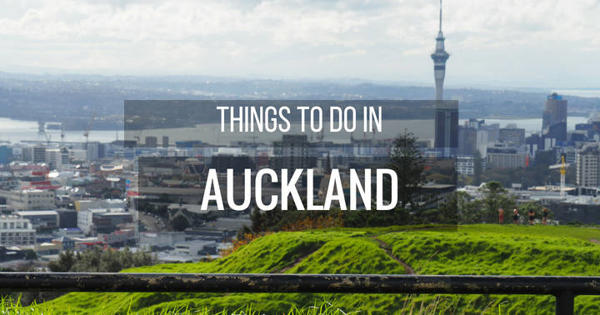How much does it cost living in New Zealand as someone doing the Working Holiday in New Zealand (Here’s how to get the visa)?
Read on to find out how much our average costs are. We will be sharing our expenditures on a monthly basis.
Table of contents:
- Cost of living in New Zealand
- Saving money during your working holiday in New Zealand
- Cost of living – North vs South Island, New Zealand
- Monthly Breakdown of Expenditure – April to Nov 2018
But first, some background information that you should know about us:
Cost of living in New Zealand
Grocery shopping and eating habits
- We don’t stinge on food when it comes to groceries.We try to compromise instead. E.g cheap bread means we can get some nuts too.
- I don’t eat a lot. I’m a very, very small eater. So, you can probably take our report as a comparison for just one person who eats A LOT.
- We cook mostly Chinese food and we cook almost everyday for lunch and dinner
- Breakfast usually consists of bread with either peanut butter or nutella
- We eat meat almost everyday. To be fair, vege and meat are both expensive here.
- We do not drink often. We just purchase a bottle of wine once in a while.
We do eat out, occasionally. Here’s are list of places with good food in New Zealand
Camper car
- One of the first things we bought when we came here was our car. Want to know how we bought ours? Check our previous post here >> Vanlife in New Zealand – how to get started
- All the reports below exclude the cost of our camper car which we aim to get back at the end of our working holiday stint.
- We have an AA membership which means we can call them up to 6 times a year for mechanical breakdown or if our car battery suddenly stops. It cost us quite a bit for the membership though. We bought insurance for the car too at the start of August, 2018. More on that in a separate post.
- Just renewed the REGO for our camper car for 8 months – this cost us $67 alone.
- WOF is due in September 2018.
- Our car (Toyota Estima) uses about 10L for every 100km.
- We have camped in this car a few times already, saving money on AirBnB
- *Cross fingers* – no major breakdowns or accidents yet
Accommodation and basic needs
- We stayed in Auckland for our first 4 months which is reputable for being a VERY expensive city. Other smaller cities may be more affordable.
- All the clothes that we bought so far, have only been for working purposes.
- Our room rental in Auckland is for a couple so it costs us NZD $250 a week. If you are alone, it might cost something like $170 a week. We get unlimited wifi, power, water, gas (for cooking), laundry, etc.
- Update (13 Sep, 2018) – We currently live in a stationary bus at a low-cost campground all the way down the south island of New Zealand and pretty close to Invercargill. We pay a weekly rent of $150. That doesn’t include hot showers ($2) and laundry ($2 for dryer and washer each). But we have unlimited power and kitchen use. No Wifi though.
- Our camper car came with a lot of things – dish washing liquid, cooking utensils, crockery, bedding, tissue paper, sunscreen, laundry powder etc so we just moved everything to our room. The only thing we bought were a basic set of hangers and laundry clips.
- Our toiletries are very simple – we use one soap bar for everything (he did bring his own face wash, shavers and shampoo from home though) and I don’t need to buy pads or tampons (see Turning over a new pad (Eco-friendly menstrual products). I don’t use make up or many skin care products – just one good face moisturizer and sunscreen.
- We bought our hiking shoes and winter wear back in Malaysia (here’s our full packing list is on our New Zealand Working holiday visa guide if you want to see that). Need a rain and windproof jacket to serve your time in New Zealand, regardless of the weather? We recommend the Uniqlo Blocktech Parka – see our full review here.
- We share one Spark package between us – it costs us $19 a month with up to 200 minute calls to other service providers and 2Gb of data. The data can rollover to the next month if you don’t finish it. There are also a ton of free Spark WiFi points that we can access throughout New Zealand. Granted, the speed of that free WiFi can be slow.
Job
- Only one of us has the working VISA and a thus, a job so you could take that into consideration.
- In Auckland, he had a job working in a glasshouse somewhere in Kumeu – it was a 6 day a week job that starts at 7.30am and ends at 5pm.
- Some jobs like fruit picking or packing are very weather dependent. If it rains, you won’t need to work (and you won’t be paid)
Commuting to work and getting around in New Zealand
- We’ve been on a few road trips already. The longest was our 1 month self-drive trip from the north to south island, New Zealand.
- We took a ferry once to Waiheke Island and that was pretty expensive. We’ve also taken the Interislander ferry between New Zealand’s North and Sound island before.
- The local bus system in Auckland is very slow and costs add up significantly if you use this for daily transport (even with the AT Hop card).
- In Auckland, he carpooled to work with colleagues daily and they split the petrol cost. Petrol is about $2 per liter here.
Okay, now that that’s all clarified, we can start with our first monthly report. We track ALL our expenditures in an excel sheet daily so this is as accurate as it gets, folks.
Saving money during your working holiday in New Zealand
Update: 1 June, 2018 – We’ve saved about $500+ after almost 2 months in New Zealand.
Update: 6 July 2018,we’ve saved $2,200 after 3 months in New Zealand.
Altogether, we brought a sum of $8,000 to New Zealand. $6,500 of which, went to the camper car so we made do with the balance of $1500 and eventually ate into our back-up cash (won’t disclose the amount here) that is for emergencies. The recommended amount (based on this site) for bringing to New Zealand when you come in on your working holiday Visa is $2,500. As you can see from the last red line on the right, we spent about $3,000 for two people in our first month in New Zealand.
We did sell off the surfboard that came with our van for $250 – that is also included in this graph (From day 7 and onward). He received his first paycheck on Day 20 the second paycheck came in on Day 26 and subsequently Day 34.
Update: 13 Sep, 2018 – Late update but here it is, our July and August financial reports.
Update: 2 Oct, 2018 – If you refer to this breakeven graph, we have used up our savings from our first 4 months of working in Auckland. What this graph also says is that we exceeded the break-even point (that’s when the blue and red lines are at the same level) sometime around Day 60. After August however, we’re in negative again by around $800 NZD.
During September, we still did some amount of travelling during the weekends. Mostly to chase the very elusive Southern lights. And that pushed us further into the red. Petrol is more expensive in the South Island of New Zealand.
Update: 1 Nov, 2018 – Approaching breakeven again after 40 days working in Southland.
Update: 30 Nov, 2018
More details further below in the November breakdown graph.

Blue is what we earned (or rather, what he earns) and red is what we spent. If both of us were working, it would have been twice as fast. Again, the camper car cost has been removed but everything else is in.
If you want to see what we spent our money on (besides the car), check out the next few graphs.
Money tips – living in Auckland (and New Zealand, in general)
- Chinese takeaways like Noodle Canteen give out large portions for a single person – we usually share one meal together at around $12-15
- Get an AT hop card before you leave the airport after your arrival.
- If using the bus in Auckland, make sure you give yourself an hour’s buffer if you have an appointment to make
- Fuel isn’t at a fixed price around New Zealand. There’s an app that we use called Gaspy that lets us compare nearby petrol stations for lower prices. The lowest we’ve ever seen so far is $1.92. Those few cents do add up if you’ve got a whole tank to fill.
- Don’t buy groceries at sundry shops if you can help it. The prices are much higher than in a supermarket like Countdown or Pak n Save. E.g.) $4 for bread vs $1 bread.
- There are small fresh vegetable and fruit stores that do have weekly deals though – we follow them on Facebook so we can see their deals. Tomatoes and capsicums are surprisingly costly here. It’s a steal if you can get a whole bag of tomatoes for less than $2. A stalk of broccoli usually costs more than $2, getting it at $1.50 is considered cheap. And so on, and so forth.
- Buy in bulk and split with your friends!
Cost of living – North vs South Island, New Zealand
What is the difference between the cost of living in North and South Island?
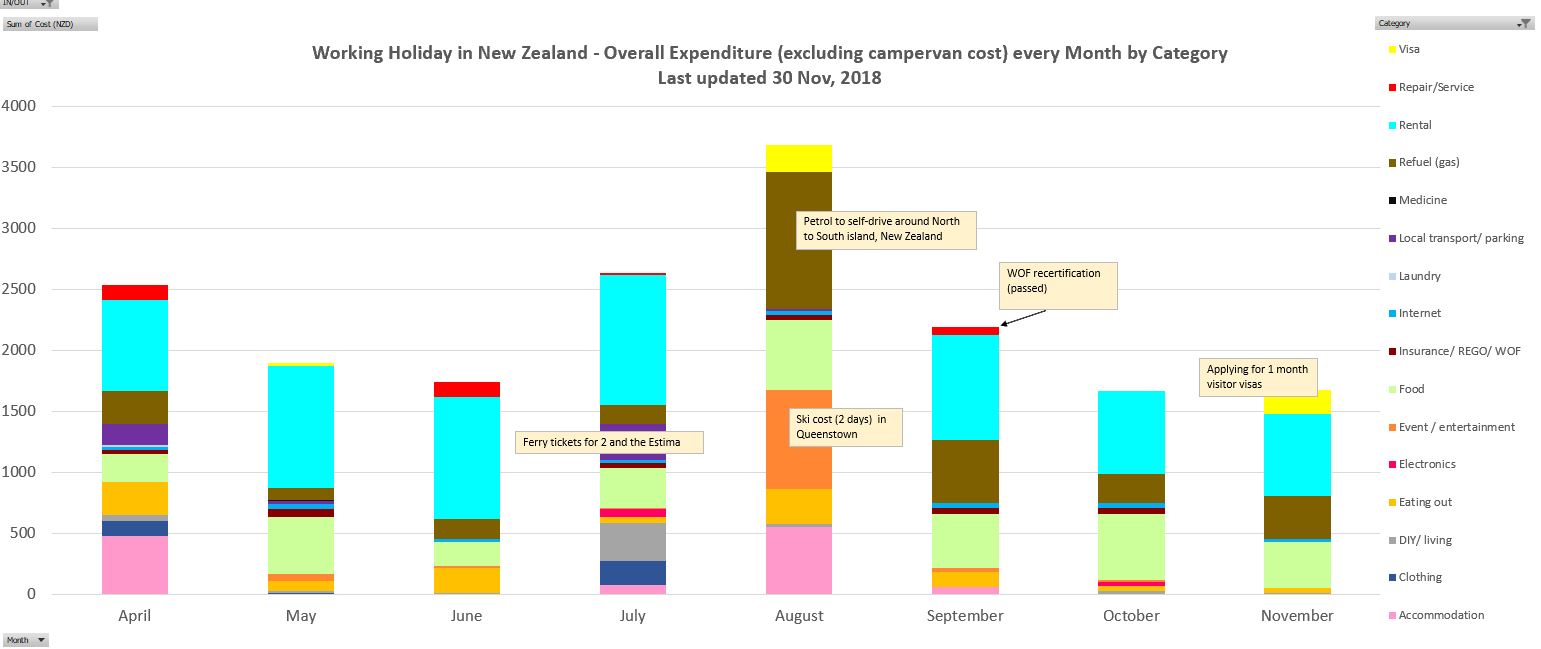
By now, we’ve been in the Southland long enough to know the living cost comparison between a big city in the North island (i.e. Auckland) and a small township in the South Island (i.e. Wyndham).
Average cost of long-term accommodation per month
Accommodation usually takes up 40% of what we spend every month. If you can survive on free campsites most of the time, then you will definitely save a lot.
When we were staying in Auckland, we’d pay an average of $1000 on rental and AirBnBs in a month. That is on a couple rate too. In our current place (i.e. stationary converted camper bus), we just pay around 60% of that amount (i.e. saving 40%).
But most of what we save on accommodation seems to be spent on fuel:
Average cost of fuel per month
In Auckland, it was usually $2 per litre. While over here, it can go up to $2.6 per litre. That amounted to an average of $150/month for fuel in Auckland. Now, we pay an average of $300/month in the South Island. And to drive down from the North to South Island cost us $1000 in petrol in one whole month.
What does remain rather consistent is the cost of food:
Average cost of food per month
Every month, we spend around $400 on groceries and eating out (at least twice a month). If you think going vegetarian would be cheaper, think again. Seemingly ordinary vegetables like tomatoes, spinach, garlic, ginger and capsicums can cost a lot more (at least if we’re comparing the prices back to our home country, Malaysia).
Monthly Breakdown of Expenditure – April to Nov 2018
Apr to Jun 2018 – Financial expenditure breakdown
Update: 6, July 2018
- On average, accommodation takes up 50% of the expenditure while food usually takes 20%.
- Fuel can cost a lot – In April we did our Tongariro trip and in May, we went to Coromandel.
- In June, we did the engine oil change for our car ourselves (actually, I wasn’t involved at all) – the tools and new engine oil cost us roughly $100.
- In July, he bought a brand new winter jacket from Kathmandu because the ones he brought are not thick enough for what we plan to do later this year.
- I went back to Malaysia for the whole of June so the graph for June should more or less represent one person’s spending (although we still paid our couple room rental rate of $250). He went out a few times with friends as indicated in the graph under “Eating Out”.
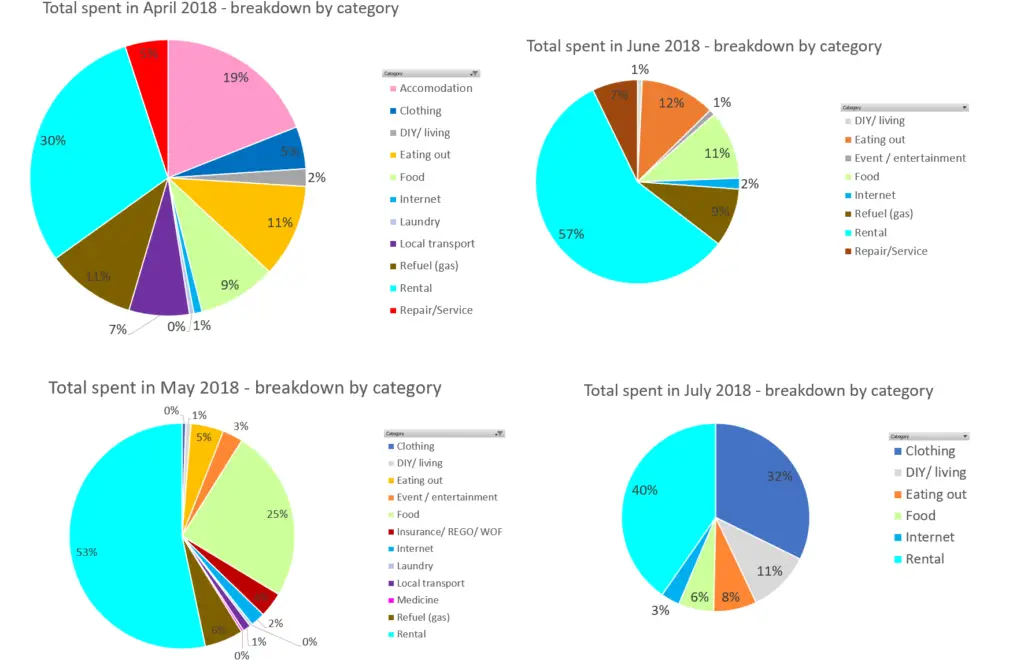
Let’s breakdown July (ignore the last July graph in the last update):
July 2018 – Financial expenditure breakdown
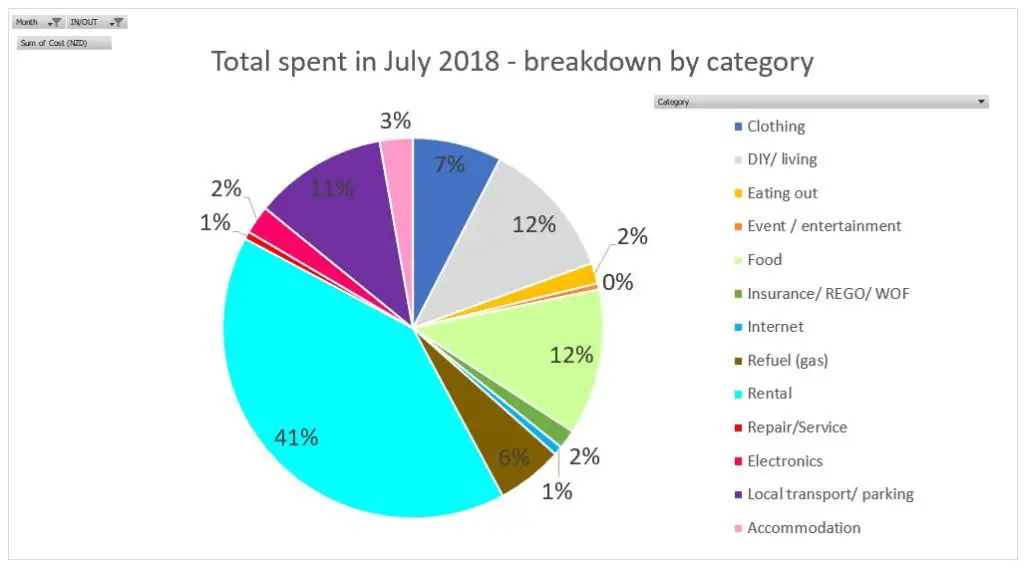
We had our last month of rental to pay. And we bought our ferry ticket (in purple) to the South Island. Kathmandu was having winter sales too and somebody picked up a laptop bag he fancied, together with a down jacket.
Lastly, we bought insurance for our car before we started our trip.
August 2018 – Financial expenditure breakdown

The bulk of it was petrol 91 (in brown). And that is not cheap in the South Island, especially around Franz Josef and Queenstown. We tried our best to scope out and fill our tank at any cheap gas station along our route but sometimes, it can’t be avoided.
I think we saved a lot of money having a certified self-contained car though:
We didn’t have to pay for powered sites or cabins. We stuck to unpowered sites and slept in our car for most nights but used holiday park facilities or public toilets. Occasionally, we splurged on a nice Airbnb room.
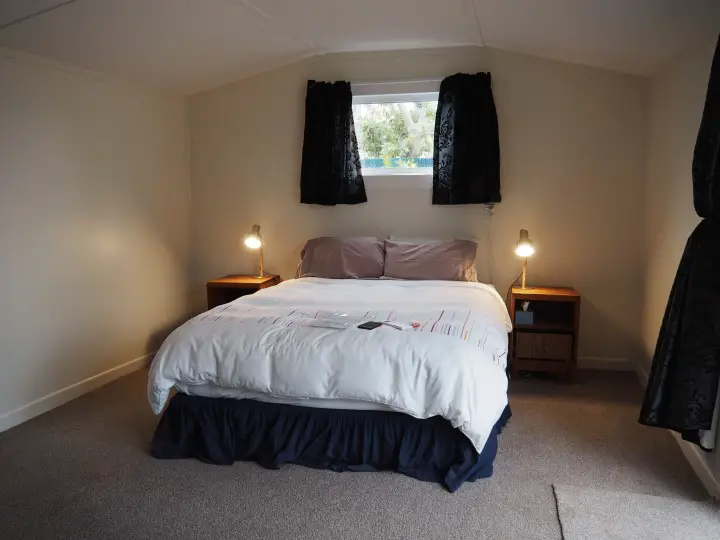
It became more of a struggle to cook from our van as we headed down the West Coast:
Sandflies pestered us and the wind blew our fire out if we didn’t shelter the stove. Washing dishes out in the cold was not fun but I think we’ve gotten wiser with water usage in that regard.
The overall cost of expenditure in August would’ve been a lot higher if not for the fact that our heli hike in Franz Josef was cancelled and refunded back to us.
And of course, we couldn’t resist sampling some local cuisine sometimes. That’s the Eating Out portion of the pie chart.

Another sizeable piece of the pie was the immigration fees (at $208 NZD) for the working holiday visa extension.
The large chunk in orange were our ski lessons in Queenstown. We paid for the starter package for the first day and the lift pass and ski rentals for the second day.
Read more on Skiing in New Zealand – what first-timers need to know.
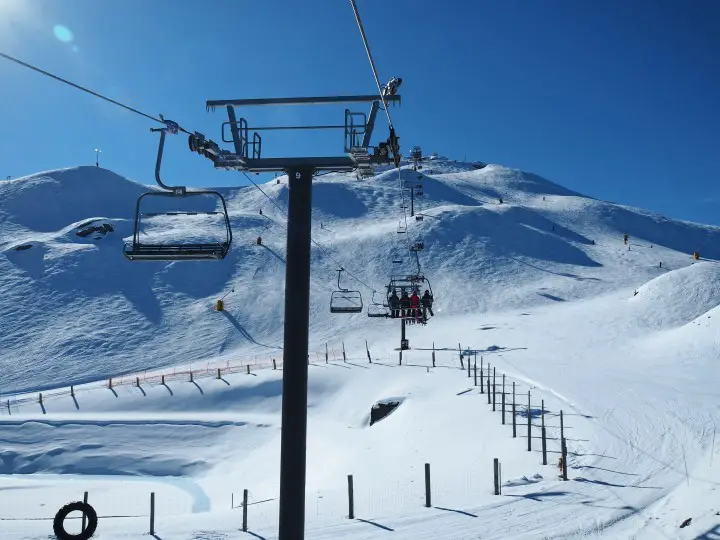
One month of travel under $4,000 NZD for two people is not too bad, I think. I’m proud to say that there were no instant noodles involved throughout the journey. Our diet did not have to suffer at the expense of the trip budget.
Out of the 6 months we’ve been in New Zealand, one of us was working in a glasshouse planting capsicum for 4 months. That earned roughly $11,000 NZD. Which seems like a lot if you convert that back to ringgit (~RM 30,000 for working for 4 months only).
But we didn’t save anything after 1 month of travelling. See our itinerary outline here.
There’s not much travelling for now. We’re just saving up money again to explore the northern part of South Island. And hopefully, the very north of New Zealand too.
Update: 2 Oct, 2018
September 2018 – Financial expenditure breakdown
Not surprisingly, the main contributors are rental and petrol.
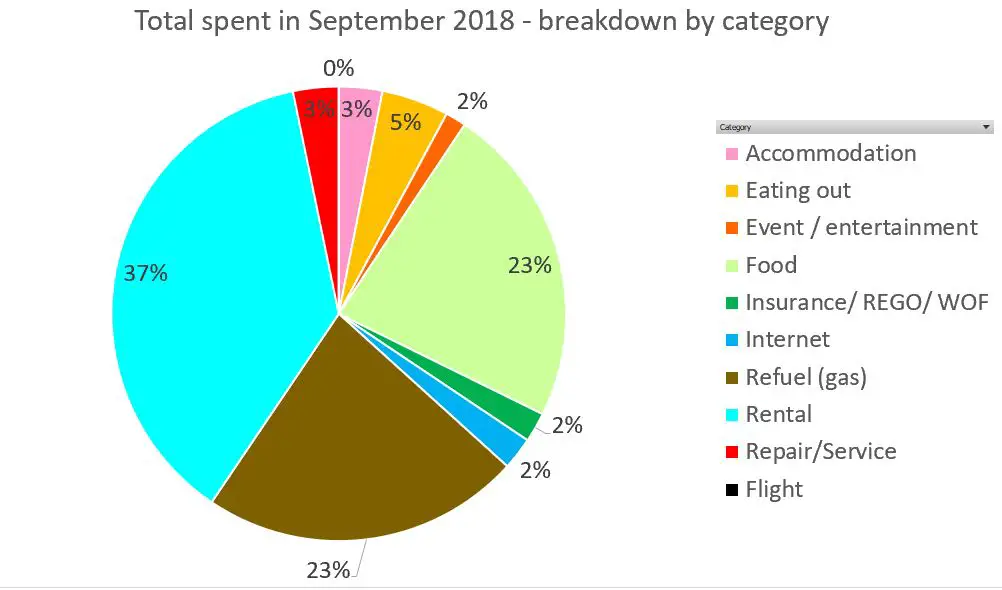
We do go out during the weekends so that falls under eating out, events and accommodation (paid campsite). And we drove all the way up to Central Otago again to collect a passport (for the working holiday visa extension).
Besides this, we got our WOF re-certified (passed with no major issues). That cost us $59 for the inspection fee.
That’s it for the September update. Hopefully, we can push the breakeven point again by the end of October.
Did we managed to hit breakeven?
October 2018 – Financial expenditure breakdown
No. But just barely if you refer to the chart below. It took us 40 days to reach this point.
Compared to our other months in New Zealand, October is the lowest.
To be fair:
We watched what we spent. Every week during October.
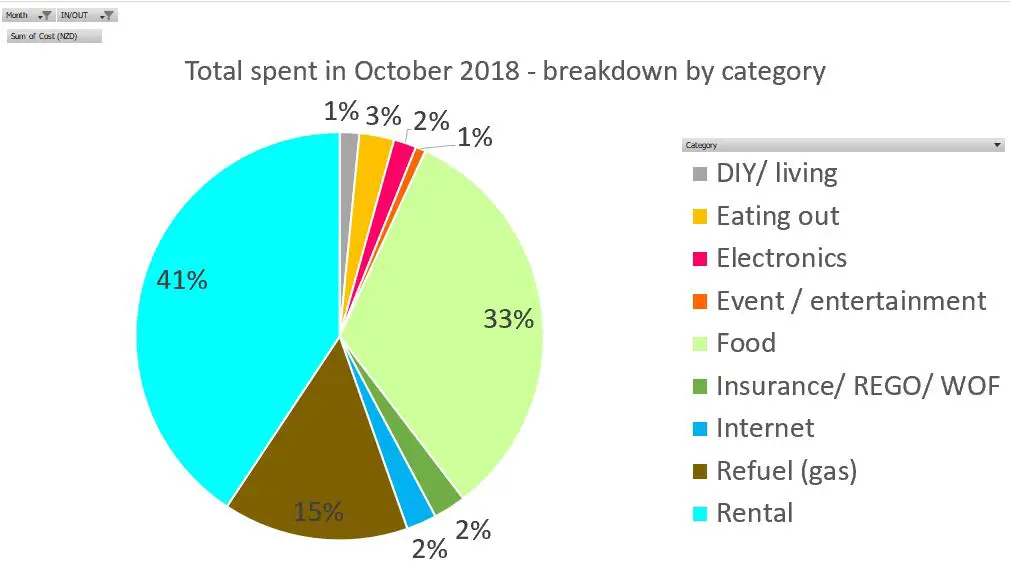
Our expenditure trend for October is very similar to September so there’s not much to divulge from there.
We did however, managed to go to Dunedin during the Labor weekend. And for both nights that we stayed there, we chose a free campsite.
November 2018 – Financial expenditure breakdown
Good news and bad news, guys.
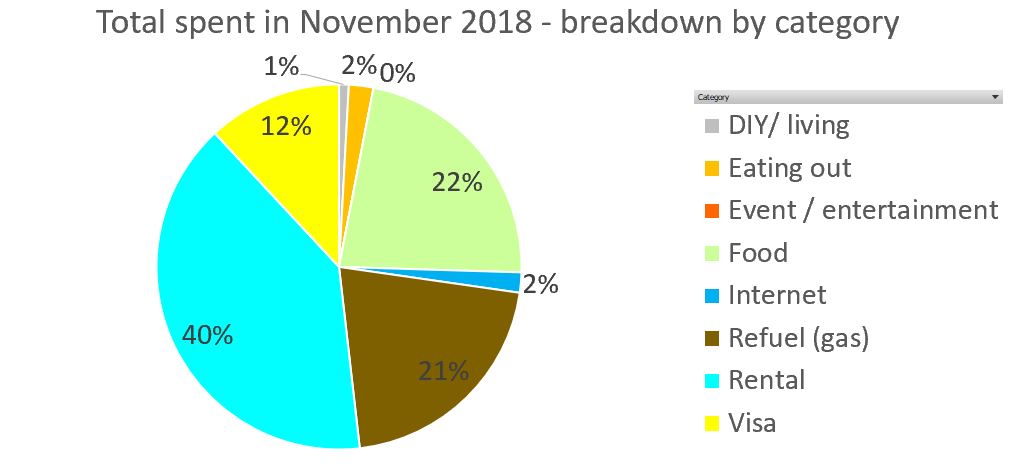
Bad news?
What we have saved in Southland won’t last long. We’ve got at least 1 months’ more of travel to do up in Northland (including the ferry tickets too). Partner officially stops work at Edendale next week. Didn’t get any of the highly sought-after cherry-picking jobs either.
Also, applying for visitor visas (we need one each for January) can come up to a significant sum. But less than flying out to Australia for a quick trip and coming back. We were initially thinking of Gold Coast but it ended up to be out of our budget.
PM us on Facebook if you want the Gold Coast 1-week itinerary. Still have it.
Good news?
This month, we are past the breakeven point while managing to see more of Fiordland (and on a budget). And my dad’s coming to visit us next week. And he offered to sponsor us provided we drive and plan everything. Which we’re more than happy to do anyways.
That’s it for this months’ update.
PS: If you know anyone who will be in North Island, New Zealand towards the last weeks of January searching for a good camper car, let them know we’ll be selling ours then. Thanks!
Conclusion
I know this post is a little messy but it should serve as an excellent reference if you’re trying to track or reduce your financial expenditures while your in New Zealand. Remember, our situation was a bit unique. One of us had the visitor visa (not allowed to work, even for food or accommodation) while the other had the working holiday visa. Essentially, we were living off his paychecks and a portion of our savings from our working days in Malaysia.
How are you going to save money while your in New Zealand? Leave a comment below.
Read also:
Want to know more about the working holiday visa in New Zealand?
Already got a working holiday visa for New Zealand? Here’s how you can extend it.
Pin this post on your Pinterest account for future reference!
